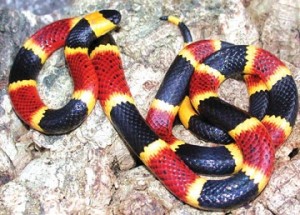Coral Snake
The coral snake has by far the most deadly venom of all North American snakes, a neurotoxin very similar to a cobra’s (they’re in the same family). On the bright side, they are notoriously reclusive and rarely bite humans.
Due to the placement of their fangs, these snakes must hold on for a few seconds and make a chewing motion to inject their venom. Thus, many bites don’t result in any venom injected at all.
In the old days, it’s estimated that 10% of coral snake bites resulted in death. Since the availability of the anti venom, there have been no recorded deaths from coral snake bites in the US.

Now, for the identification. These snakes stand out as entirely different from the others on this list, because they are not vipers. As I mentioned, they belong to the Elapidae family of snakes, which includes the cobra.
Unlike vipers, coral snakes don’t have especially large heads in proportion to their bodies. They are also very brightly colored, with a pattern of red and black stripes with yellow (sometimes white) bands in between.
In fact the same rhyme can be used to identify the vast majority of US coral snakes, “Red and black, friend of Jack. Red and yellow, kill a fellow.”
Translation: If the snakes red and yellow bands touch, it is a highly venomous coral snake. If it’s red and black bands touch, it’s a non-venomous king snake.
Several harmless species, e.g. the scarlet king snake look very similar to the coral snake to the novice. The distinguishing factor is the fact that it has red and black bands that touch. It’s red and yellow bands do not meet.
RELATED: Watch This Crazy Fisherman Try to Hand Feed a Water Snake! [VIDEO]
